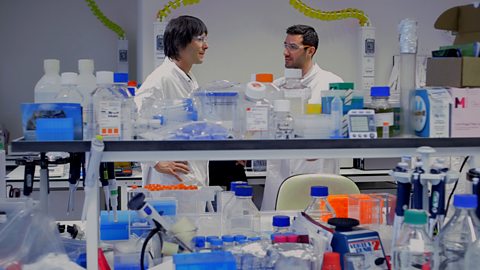Video summary
Professor Brian Cox meets a plant scientist who describes the benefits of genetic modification of plants. Brian then describes the history of the discovery of DNA in Cambridge by Crick and Watson.
He discusses the work of Rosalind Franklin, explains the significance of Photograph 51 and outlines how this allowed her to suggest the double helix structure, leading to Crick and Watson being able to build their famous model.
He describes the significance of genetic sequencing and how this has ultimately led to the controversy around genetic modification.
This short film is from the łÉČËżěĘÖ series, Science Britannica.
Teacher Notes
This short film could be used to launch classroom discussions on selective breeding and genetic modification.
Students could discuss some other ways in which scientific activity impacts on the environment.
Encourage students to consider other controversies in science and debate on the pros and cons of scientific progress.
This short film is relevant for teaching biology at KS3 and KS4/GCSE.
Appears in OCR, Edexcel, AQA, WJEC in England and Wales, CCEA GCSE in Northern Ireland and SQA National 4 in Scotland.
Targeted research. video
Brian Cox learns about targeted research in the modern pharmaceutical industry and how by focusing only on positive results, it fails to report negative results.

John Hunter and public engagement in science. video
Brian Cox describes how John Hunter pushed the boundaries of medicine using corpses obtained from grave-robbing and how he set up a museum to open minds about medical research.

William Perkin and making scientific discoveries by chance. video
Brian Cox uses William Perkin's discovery of mauveine to explain how scientific discoveries are sometimes made by chance.

Sir Isaac Newton and the scientific method. video
Brian Cox outlines the historical context of the era in which Newton began to be interested in the nature of the visible spectrum obtained using a prism.

John Tyndall and blue skies research. video
Brian Cox describes the work of John Tyndall and his attempts to explain what makes the sky blue and the sunset red.

Who was Henry Cavendish? video
Professor Brian Cox introduces Henry Cavendish, the 18th Century scientist who investigated hydrogen, came up with the formula H20 and founded the Royal Institution.

Who was Humphry Davy? video
Brian Cox follows in the footsteps of 19th Century chemist Humphry Davy, recreating one of his explosive experiments that he used to impress the crowds at the Royal Institution.
